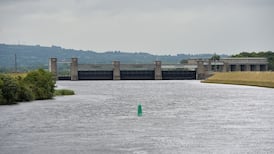A TIDAL barrier is among a range of proposed flood defences for Cork outlined in the draft report on flooding in the river Lee catchment area.
A Thames barrier-style development at the mouth of Cork harbour to prevent serious flooding has been deemed not feasible as the cost would be too high. However, engineers have examined the feasibility of locating a similar barrier around the Great Island area.
Public consultation will begin next week following the launch yesterday of the preliminary results of the massive Lee Catchment Flood Risk Assessment and Management Study.
Traders and homeowners in Cork have suffered millions of euro worth of damage in recent years because of flooding. An estimated €10 million worth of damage was caused to Cork in October 2004 after the worst flooding in the city in more than 40 years.
Arising out of the 2004 flooding and other smaller incidents, engineers have spent the last three years mapping the entire Lee catchment area – the land area drained by the river Lee, its tributaries and Cork harbour – which measures about 2,000 sq km.
Dr Martin Mansergh, Minister of State at the Office of Public Works yesterday launched the first phase of the public consultation stage of the Lee flood risk study.
At a meeting of Cork City Council in City Hall, Mr Mansergh said following more than two years of data collection, detailed surveys, site investigations, computer modelling, flood risk assessment and mapping, the Lee study was now nearing completion.
“This major study, which includes the views of relevant stakeholders and the general public, has produced flood maps for areas throughout the entire catchment, which is a first in Ireland for such a large area. It has also identified a range of potential flood risk management options where the flood risk is significant.”
Mr Mansergh said the aim of the public consultation process was both to inform people of the identified flood risks and to seek their views and feedback on the preferred flood risk management options.
From the beginning of May, members of the project team will attend a number of information days to describe the work undertaken to date as part of the study, present draft maps showing flood risk areas in Cork city and county and to discuss the range of options available to manage this risk.
The Lee flood risk study was initiated in 2006 by the Office of Public Works, Cork City Council and Cork County Council, and is a pilot study under the national Flood Risk Assessment and Management Programme to meet the requirements of the EU directive on flood risk assessment and management.
The Lee study area includes the rivers Lee, Owenboy, Owenacurra and Glashaboy and their tributaries, and Cork harbour, but focuses on urban areas with a history of flooding and areas on subject to significant development pressure that may be at risk.









